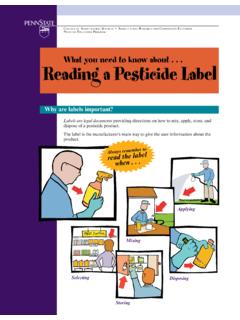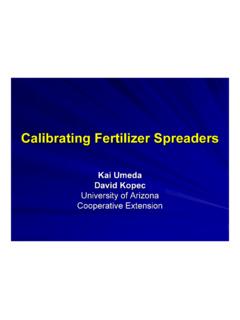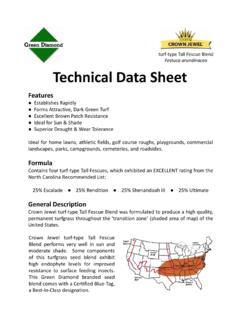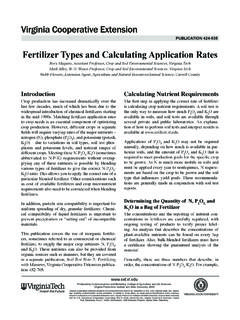Transcription of Essential Plant Nutrients - Green Resource
1 Essential Plant Nutrients :their presence in North Carolina soils and role in Plant nutritionM. Ray Tucker, AgronomistOctober 1999 Table 1. Nutrients Essential for Plant growthNutrientsNutrients from soil, lime and commercial fertilizersfrom air & waterprimary nutrientssecondary nutrientsmicronutrientscarbon (C)nitrogen (N)calcium (Ca)boron (B)hydrogen (H)phosphorus (P)magnesium (Mg)chlorine (Cl)oxygen (O)potassium (K)sulfur (S)copper (Cu)iron (Fe)manganese (Mn)molybdenum (Mo)zinc (Zn)Baron Justus von Liebig, a German scientist in the mid-19th century, showed that Nutrients are essentialfor Plant life. He stated, "We have determined that a number of elements are absolutely Essential to Plant are Essential because a Plant deprived of any one of these elements would cease to exist.
2 " He alsoauthored the term "law of the minimum," which states that " plants will use Essential elements only inproportion to each other, and the element that is in shortest supply in proportion to the rest will determinehow well the Plant uses the other nutrient elements."Knowing the Nutrients required to grow plants is only one aspect of successful crop production. Optimumyield also requires knowing the rate to apply, the method and time of application, the source of Nutrients touse, and how the elements are influenced by soil and climatic are 16 nutrient elements required to grow crops (Table 1). Three Essential Nutrients carbon (C),hydrogen (H) and oxygen (O2) are taken up from atmospheric carbon dioxide and water.
3 The other 13nutrients are taken up from the soil and are usually grouped as primary Nutrients , secondary Nutrients primary Nutrients nitrogen (N), phosphorus (P) and potassium (K) are commonly found inblended fertilizers such as 10-10-10, or equivalent grades. Primary Nutrients are utilized in the largestamounts by crops, and therefore, are applied at higher rates than secondary Nutrients and secondary Nutrients calcium (Ca), magnesium (Mg) and sulfur (S) are required in smalleramounts than the primary Nutrients . The major source for supplementing the soil with calcium andmagnesium is dolomitic lime (aglime), although these Nutrients are also available from a variety of fertilizersources.
4 Sulfur is available in fertilizers such as potassium and magnesium sulfate, gypsum (calcium sulfate)and elemental iron (Fe), manganese (Mn), zinc (Zn), copper (Cu), boron (B) and molybdenum (Mo) are required in even smaller amounts than secondary Nutrients . They are available in manganese, zinc andcopper sulfates, oxides, oxy-sulfates and chelates, as well as in boric acid and ammonium Nutrients and Plant GrowthNitrogen's RoleOf the three major Nutrients , plants require nitrogen in the largest amounts. Nitrogen promotes rapid growth,increases leaf size and quality, hastens crop maturity, and promotes fruit and seed development.
5 Becausenitrogen is a constituent of amino acids, which are required to synthesize proteins and other relatedcompounds, it plays a role in almost all Plant metabolic is an integral part of chlorophyll manufacture through photosynthesis. Photosynthesis is theprocess through which plants utilize light energy to convert atmospheric carbon dioxide into (sugars) provide energy required for growth and development. The chemical equation forphotosynthesis is6CO2 + 12H2O + 672 Kcal radiant energy = C6H12O6 + 6H2O + 6O2 North Carolina soils contain low levels of nitrogen and require annual applications to sustain crop of the applied nitrogen is carried over to subsequent growing seasons due to crop removal, leaching anddenitrification.
6 Of all the elements required for crop production, nitrogen poses the greatest environmentalthreat through contamination of surface and ground water. Nitrogen fertilizer is available in both organic (manures) and inorganic forms. The amount of nitrogen inorganic sources varies with source material and its state of decomposition. However, for commercial cropproduction, the following inorganic fertilizers are primarily used: ammonium nitrate ( ), potassiumnitrate (13% N), sodium nitrate (16% N), calcium nitrate ( N), urea (46% N), mono-ammoniumphosphate (18% N), di-ammonium phosphate (46% N) and liquid nitrogen (30% N and 10-34-0).
7 Legume crops require little or no nitrogen fertilizer. Beneficial bacteria that live in the roots of theseplants capture nitrogen from the atmosphere. This nitrogen is available for use by the Plant . Nitrogen is alsoused by microbes to break down organic DeficiencyNitrogen-deficient plants exhibit slow stunted growth, and their foliage is pale Green . Deficiency symptomsgenerally appear on the bottom leaves first. In severe cases, the lower leaves have a fired appearance onthe tips, turn brown, usually disintegrate, and fall leafy crops such as tobacco, vegetables, forage and pasture crops, low nitrogen results in low yield andquality.
8 When grain crops, such as corn and small grains, are deficient, they generally exhibit yellow leaf tips,stunted growth with spindly stalks and low yields of poor quality grain. In contrast, too much nitrogen causesexcessive vegetative growth, delays maturity, increases lodging, fosters disease and poses an environmentalthreat to surface and ground deficiency generally stems from inadequate fertilizer application, denitrification by soil microbes,or leaching loss due to excessive rainfall. Leaching occurs most commonly in sandy-textured coastal plain soilsduring periods of excessive rainfall. Nitrogen is also lost through volatilization from surface applications duringperiods of hot, dry deficiency can be corrected with an application of nitrogen fertilizer.
9 Crop response tofertilization with nitrogen is generally very prompt, depending on the source of nitrogen, stage of Plant growth,rainfall and ' RoleNormal Plant growth cannot be achieved without phosphorus. It is a constituent of nucleic acids, phospholipids,the coenzymes DNA and NADP, and most importantly ATP. It activates coenzymes for amino acid productionused in protein synthesis; it decomposes carbohydrates produced in photosynthesis; and it is involved in manyother metabolic processes required for normal growth, such as photosynthesis, glycolysis, respiration, and fatty2acid synthesis. It enhances seed germination and early growth, stimulates blooming, enhances bud set, aids inseed formation, hastens maturity and provides winter hardiness to crops planted in late fall and early meristem region of growing plants is high in phosphorus content in North Carolina soils ranges from less than 20 ppm to over 800 ppm.
10 Thehighest levels are found in soils where tobacco and vegetable crops have been grown. High concentrations arealso found in fields where heavy rates of poultry litter have been DeficiencyPhosphorus deficient plants are characterized by stunted growth, dark Green leaves with a leathery texture,and reddish purple leaf tips and margins. Reddish purple margins are characteristic of phosphorus deficiencyon corn. Symptoms usually occur on young plants when the soil temperature is below 60 symptoms may appear when soil phosphorus levels are adequate. When soil is cool, lessphosphorus is available for Plant uptake, whether or not an adequate amount is present.







